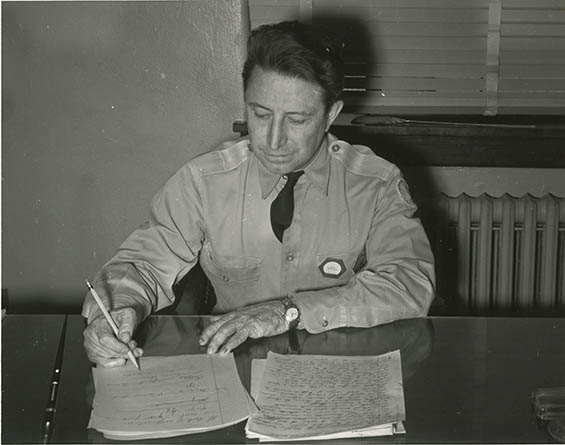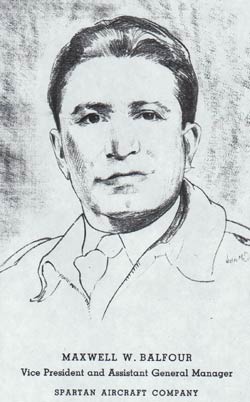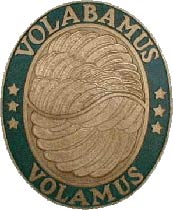|
Maxwell W. Balfour was born in Traer, Iowa June 22, 1895. He attended Northwestern University from 1914-1917, graduating with a B.A.
He was commissioned in the Army September 14, 1917 and learned to fly at Tours and Issoudun, France during 1917-18. During fifteen years of active duty with the Army, Max Balfour attained the rank of Captain and saw overseas duty with observation and pursuit squadrons, and held the office of Military Attache in Tours, France. He served as adjutant under five successive commanding officers.
He landed twice at Tucson, once as the pilot in command, and once as a passenger. As pilot, he landed Tuesday, May 4, 1926 at 6:20PM. He carried a single passenger named Gilbert Clark in the Douglas O-2-A, 25-395. Based at Garden City, NY Mitchel Field, they arrived eastbound from San Diego, CA Rockwell Field. They remained overnight, departing at 9:45AM the next day for Mitchel Field. No reason was listed for their flight.
In the late 1920s he endured a couple of horrific airplane crashes. One was reported June 28, 1929 in an unidentified news clipping in his NASM folder (cited, left sidebar). His training plane caught fire at 2,000' over Long Island. He and his passenger discharged all the fire extinguishers to no effect. The plane headed for the ground comet-like and crashed at the Meadowbrook Country Club. Both survived with serious injuries. The following photograph comes to us courtesy of frequent site visitor and Tulsa historian Kevin Gray. It was probably snapped after his retirement from the military (see below).
Max Balfour, Roosevelt Field (?), Late 1930s (?) (Source: Gray)
 |
As well, a little earlier, Balfour and another passenger had to abandon their aircraft and descend by parachute. The New York Times estimated the altitude at "about 3,000 feet" when the wings failed on Balfour's Curtiss Falcon O-11 aircraft. Again the airplane crashed at the Meadowbrook Country Club. That time it tore through the roof of a stable killing two polo ponies He and his passenger survived. The photograph shows what was probably the result of this crash. Note his hands. His left pinkie finger is missing and his fingers and nails appear scarred as from burns.
Maxwell W. Balfour, Ca. Early 1940s (Source: NASM)
 |
As passenger, Balfour landed Tuesday, September 15, 1931 with B.H. Warburton, Jr. as his pilot in the Stinson Jr. identified as NC10867. Warburton carried his wife as second passenger. Based at Philadelphia, PA, they were westbound from El Paso, TX to San Diego, CA. No purpose was given for their trip.
He retired from the army October 31, 1931 with a physical disability that might have been related to his crash (note his flight, above, through Tucson six weeks earlier as a passenger). He then took up the life of a private pilot and of training pilots and technicians. He acquired commercial pilot license no. 2002.
Balfour worked at the Roosevelt Aviation School, Mineola, LI from 1936-39, then directed the U.S. Army Air Corps Training Detachment there until 1941. In 1941 he became vice president of the Spartan Aircraft Company, Tulsa, OK. He accumulated about 4,000 flight hours through 1942.
He had a daughter, Claude, whom the New York Times of December 10, 1941 reported was engaged to be married to aviation cadet John T. Swais based at Brooks Field, San Antonio, TX. He remained active in the administrative and organizational aspects of his business, and The New York Times of May 25, 1952 reported his appointment as vice president of the Aeronautical Training Society. The Society was composed of representatives of flying schools.
Baldwin retired from Spartan in 1961 and died during August, 1977 at age 82 in Tulsa, OK. In his obituary that appeared in the August 10, 1977 New York Times, he was cited as associating with many famous aviators over the years, notably Charles Lindbergh. In Oklahoma he was associated with various oilmen like J. Paul Getty and W.G. Skelly. Skelly had founded the Spartan company in 1928. Getty took over personal control of the Spartan Aircraft Company in 1942, but was content to leave the school in the hands of Balfour, calling him, "... the best executive with whom I've worked." He was a member of the Quiet Birdmen, Veterans of Foreign Wars, the American Legion and the Order of Daedalians, whose logo shield appears in the upper left-hand corner of this page.
---o0o---
Dossier 2.2.22
THIS PAGE UPLOADED: 10/17/11 REVISED: 07/09/15
|



